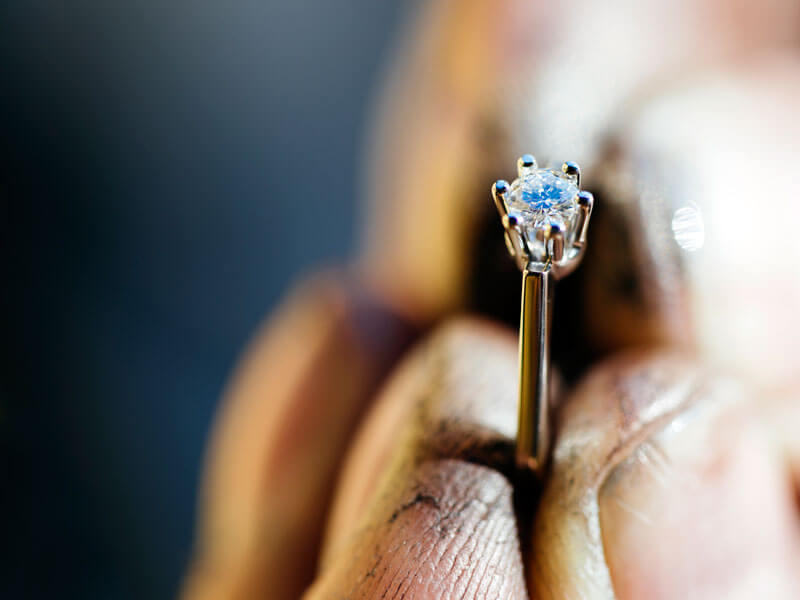Diamonds have long been symbols of luxury, love, and enduring beauty. However, with the rise of sustainability concerns and technological advancements, lab-made diamonds have emerged as a strong contender to natural diamonds. While both types of diamonds appear similar to the naked eye, they differ significantly in their origins, properties, and impact. Here’s a detailed comparison to help you understand the distinctions between lab-made diamonds and real (natural) diamonds.
1. Origin and Formation
- Natural Diamonds: Real diamonds are formed deep within the Earth’s crust under extreme heat and pressure, taking millions to billions of years. The natural process involves carbon atoms being crystallized over time, resulting in the formation of rough diamonds.
- Lab-Made Diamonds: Also known as synthetic or cultured diamonds, lab-made diamonds are created in controlled laboratory environments using two main techniques: lab made diamonds vs real. These processes mimic the natural conditions that form diamonds, but they take only weeks to months to produce a diamond.
2. Chemical Composition and Physical Properties
Both lab-made diamonds and natural diamonds are chemically identical. Both are made of pure carbon atoms arranged in a crystal lattice structure. The fundamental properties of both types of diamonds are virtually the same:
- Hardness: Both types have a hardness rating of 10 on the Mohs scale, meaning they are equally durable.
- Light Performance: Lab-made and natural diamonds exhibit the same brilliance, sparkle, and fire (the dispersion of light into colors). Both types are indistinguishable to the naked eye when it comes to light reflection.
3. Appearance
- Natural Diamonds: Natural diamonds can contain inclusions (tiny imperfections) and other natural characteristics formed during their lengthy geological process. These inclusions can sometimes be seen under magnification.
- Lab-Made Diamonds: Lab-grown diamonds can also contain inclusions, but the nature of these inclusions is different. Modern technology allows scientists to control the formation of diamonds, which means these inclusions may be more uniform and easier to detect under magnification.
While both types of diamonds look almost identical, a gemologist can distinguish between the two with specialized equipment, such as a diamond tester or microscope.
4. Environmental and Ethical Considerations
- Natural Diamonds: The extraction of natural diamonds involves mining, which can have significant environmental and ethical impacts, including land destruction, habitat disruption, and potential human rights violations in some regions.
- Lab-Made Diamonds: Lab-grown diamonds are considered a more environmentally friendly and ethical alternative. They require less energy than mining, do not contribute to deforestation, and do not involve exploitative labor practices. The overall carbon footprint of lab-made diamonds is typically lower compared to mined diamonds.
5. Cost
- Natural Diamonds: Due to their rarity and the extensive process required to mine them, natural diamonds are typically much more expensive. The price is also affected by factors such as size, color, clarity, and cut.
- Lab-Made Diamonds: Lab-grown diamonds are generally 20-40% less expensive than their natural counterparts. This price difference is mainly due to the reduced costs associated with production and the lack of supply chain challenges faced by mined diamonds.
6. Market Perception and Value
- Natural Diamonds: Real diamonds have been valued for centuries as prestigious gemstones. They hold substantial cultural and emotional significance, especially in engagement rings and other fine jewelry. However, their resale value can be affected by market trends and the rarity of the stone.
- Lab-Made Diamonds: While lab-grown diamonds are growing in popularity, they are often perceived as less prestigious than natural diamonds. Their resale value is generally lower, as they are not considered as rare or valuable in the traditional sense. However, their popularity is expected to increase as more people prioritize sustainability and cost-effectiveness.
7. Availability and Customization
- Natural Diamonds: Availability can be limited depending on the quality, size, and rarity of the diamond. Exceptional diamonds, such as large stones with perfect clarity or color, man made diamonds, are rarer and often command higher prices.
- Lab-Made Diamonds: Lab-grown diamonds offer greater availability and can be produced in any size, shape, and quality. This means buyers have a larger selection and can more easily find a diamond that meets their preferences in terms of aesthetics and budget.
8. Longevity
Both natural and lab-made diamonds are incredibly durable and will last a lifetime. Neither will degrade or lose their beauty over time. The longevity of both types of diamonds makes them ideal choices for heirloom jewelry.
9. Conclusion: Which is Better?
The choice between a lab-made diamond and a natural diamond ultimately depends on personal values, budget, and preferences:
- Choose a Natural Diamond if you value tradition, rarity, and the long-standing cultural significance of diamonds. A natural diamond may also be a better option if you’re interested in long-term investment potential.
- Choose a Lab-Made Diamond if you are focused on sustainability, ethical sourcing, and lower costs. Lab-made diamonds also offer customization options that can make them appealing for those who want a specific type of diamond that may not be as readily available in the natural world.
In the end, both types of diamonds are equally stunning and can serve as a beautiful symbol of love and commitment. The decision to choose between them should reflect your personal beliefs, priorities, and desires.

